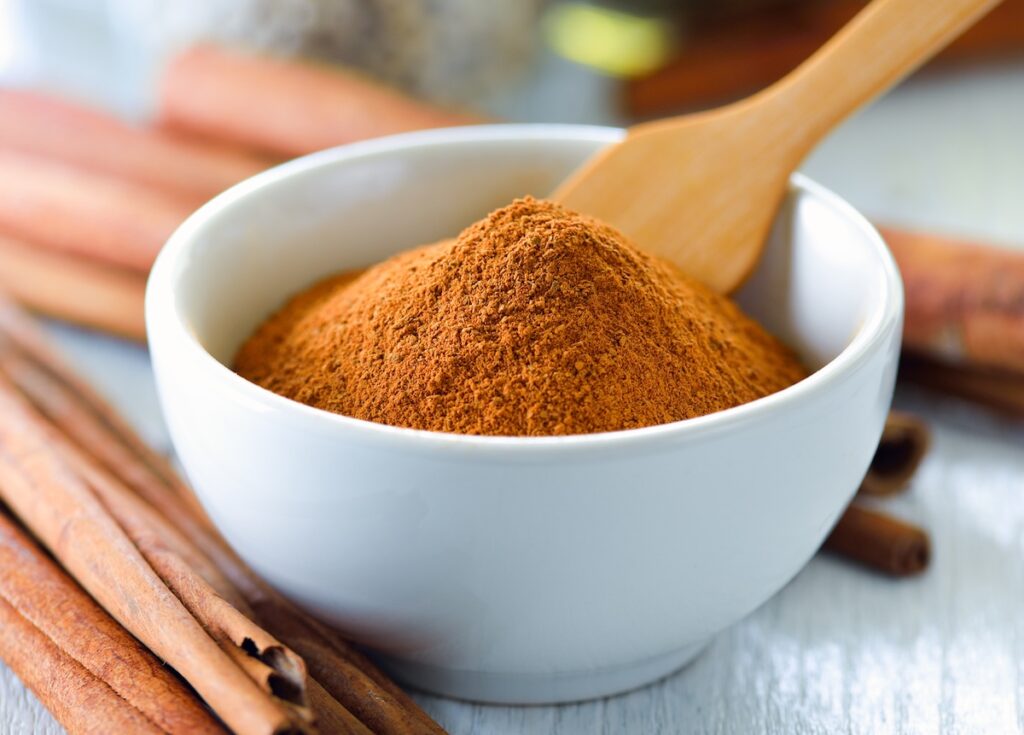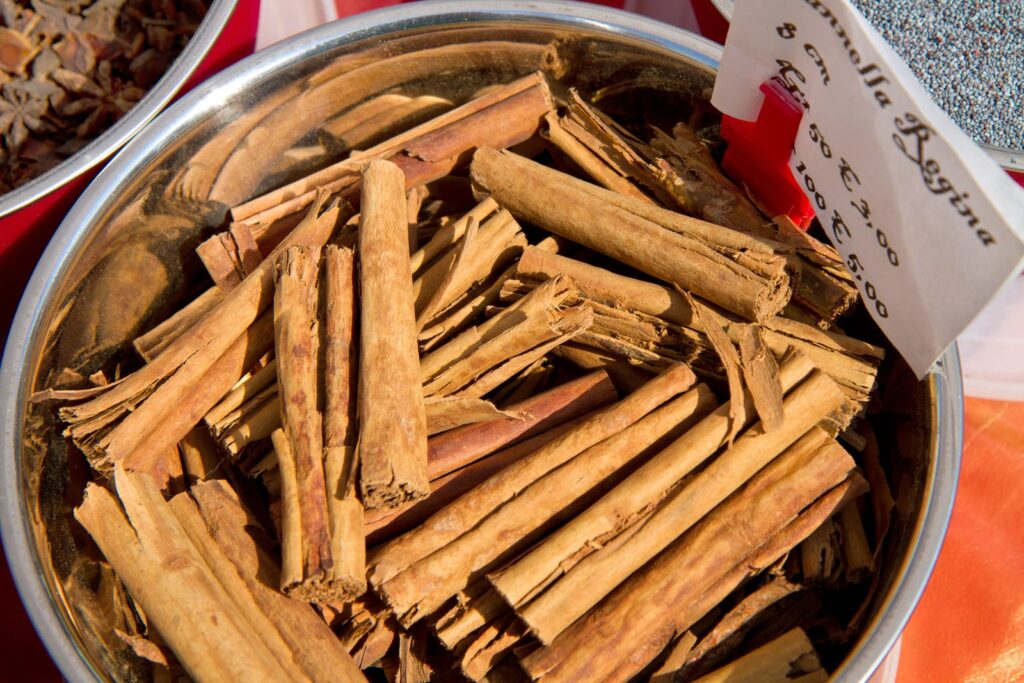The inclusion of cinnamon in cappuccino is a matter of personal preference and can vary from one recipe to another. Some people enjoy the warmth that cinnamon adds, while others believe it detracts from the authentic cappuccino experience.
Cinnamon In Traditional Cappuccino
Traditional Italian cappuccinos don’t actually include cinnamon in the original recipe. People started adding cinnamon later, mostly because of regional tastes and modern coffee shop trends.
Classic Cappuccino Ingredients
Classic cappuccino has just three main parts: espresso, steamed milk, and milk foam. They’re all in equal amounts.
The recipe sticks to a 1:1:1 ratio. One part espresso makes up the base. One part steamed milk brings in the creaminess.
One part milk foam finishes it off and gives that signature texture. No spices or extra flavorings go into a real Italian cappuccino.
The drink depends on good coffee beans and well-prepared milk. Italian coffee culture really values the pure taste of espresso with milk. Adding other flavors would just cover up the coffee’s natural qualities.

Evolution of Toppings and Additions
Modern cappuccinos often come with toppings that weren’t there before. You’ll spot cocoa powder or cinnamon on top at plenty of coffee shops these days.
Cocoa powder became a thing in Europe and Australia, mostly as a finishing touch. Cinnamon, on the other hand, really took off in American coffee shops.
People add these for both the look and the taste. A dusting on top looks nice and brings out new flavors.
American coffee chains like Starbucks made cinnamon cappuccinos popular. This trend spread to other countries as coffee culture went global.
Lots of coffee shops now add these toppings by default unless you ask them not to.
Regional Differences in Preparation
Italian cappuccinos stick pretty close to tradition. You won’t usually see cinnamon in real Italian cafes.
In Europe, cocoa powder is more common than cinnamon. It gives a chocolatey finish that pairs well with espresso.
North American coffee shops often add cinnamon automatically. Many people expect it now as part of the drink.
Different regions have their own cappuccino styles:
- Italy: Just espresso, steamed milk, and foam
- Europe/Australia: Usually topped with cocoa powder
- United States: Often comes with cinnamon dusting
- Other regions: Local twists and preferences
What goes in your cappuccino really depends on where you get it and the shop’s style.
Origins and Production
Cinnamon comes from the inner bark of evergreen trees in the Cinnamomum family. The most common types are:
Ceylon cinnamon (Cinnamomum verum) – originally from Sri Lanka, considered “true” cinnamon with a delicate, sweet flavor
Cassia cinnamon (Cinnamomum cassia) – from China and Southeast Asia, stronger and more common in grocery stores

To harvest it, farmers cut shoots from cinnamon trees, remove the outer bark, and peel off the inner bark in long strips. As these strips dry, they naturally curl into the familiar cinnamon stick shape. The bark can also be ground into powder.
Most of the world’s cinnamon still comes from Sri Lanka, Indonesia, China, and Vietnam, where the trees grow naturally in tropical climates.
For cappuccinos and most coffee drinks, cassia cinnamon is much more commonly used than Ceylon cinnamon. Here’s why:
Cassia has a stronger, more robust flavor that can hold its own against the bold taste of espresso. It’s also what most people expect when they taste “cinnamon” – that familiar, intense cinnamon flavor you get in cinnamon rolls or spice lattes.
Ceylon cinnamon is more delicate and subtle, with a sweeter, almost floral quality. While some specialty coffee shops might use it for a more refined flavor, it can easily get overwhelmed by strong coffee.
Practically speaking, cassia is also much cheaper and more widely available – it’s what you’ll find in most grocery stores labeled simply as “cinnamon.” The big coffee chains like Starbucks almost certainly use cassia in their cinnamon-flavored drinks.
That said, if you’re making cappuccinos at home and want to experiment, Ceylon cinnamon can create a more nuanced, sophisticated flavor – you’d just need to use a bit more of it or pair it carefully with the coffee’s intensity.
Role of Cinnamon in Cappuccino
Cinnamon’s a popular way to add warmth and aroma to cappuccino. While it’s not part of the original Italian recipe, cinnamon has become a go-to option that changes up the classic drink.
Flavor Profile Enhancements
When you toss cinnamon into your cappuccino, you get a cozy, spicy kick that pairs with espresso’s boldness. The spice brings out a bit of sweetness in the milk and tones down the coffee’s bitterness.
Cinnamon adds these flavor changes:
- Warmth: Gives a comforting feel
- Sweetness: Adds natural sweetness (no sugar needed)
- Aroma: Makes the drink smell spicy and inviting
- Complexity: Layers new flavors over the coffee base
The spice really works with the creamy steamed milk. It blends into the foam, so every sip picks up the flavor.
Your taste buds notice how cinnamon softens any harsh coffee edges. Each sip feels smoother and more balanced.
When Cinnamon Is Added
You can add cinnamon at a few different points when making cappuccino. Each method changes how strong or even the flavor feels.
Here are some common ways:
| Method | When Added | Flavor Result |
|---|---|---|
| Powder dusting | After foam creation | Light, surface flavor |
| Mixed in milk | During steaming | Deep, integrated taste |
| Syrup form | Before milk addition | Sweet, uniform flavor |
| Ground spice | With espresso grounds | Strong, coffee-blend taste |
Most coffee shops just sprinkle cinnamon powder on top when the drink’s done. You get the scent right as you bring the cup up.
Some baristas stir cinnamon into the milk while steaming. That way, the flavor spreads through the whole drink.
How to Make a Cinnamon Cappuccino at Home
To make a cinnamon cappuccino, you just need good espresso, steamed milk, and some ground cinnamon or cinnamon syrup. The trick is getting the spice to balance with the coffee’s boldness.
Essential Ingredients Needed
Start with 1 shot of espresso or about ½ cup of strong brewed coffee. Fresh espresso gives you the most authentic taste.
Use ½ cup of whole milk for the richest foam. Whole milk froths up the best, but you can swap in oat or almond milk if you want.
Grab ground cinnamon for dusting. If you’re feeling fancy, use cinnamon sticks to make syrup or add a deeper flavor.
Optional extras include vanilla extract, sugar, or honey for sweetness. Some folks use condensed milk instead of regular milk and sugar.
Make sure your milk is cold before you steam it. That helps you get better foam for your cappuccino.
Preparing Cinnamon Syrup
Combine ¼ cup water with ¼ cup sugar in a small saucepan. Toss in 1 cinnamon stick or 1 teaspoon ground cinnamon.
Heat it over medium, stirring until the sugar dissolves and it starts to boil.
Turn the heat down and let it simmer for 5-10 minutes. You’ll notice the syrup thickening and the cinnamon smell getting stronger.
Take it off the heat and let it cool for about 10 minutes. If you used a stick, strain it out.
Keep the syrup in your fridge for up to two weeks. Use 1-2 tablespoons per cappuccino, depending on how sweet you want it.
Making the syrup ahead saves time on busy mornings.
Popular Cinnamon Cappuccino Variations
Coffee shops get creative with cinnamon cappuccinos. You’ll find cold versions for hot days and all sorts of flavor mashups with different spices and ingredients.
Iced Cinnamon Cappuccino
Iced cinnamon cappuccino takes the warm spice and cools it down. Start with cold espresso shots and use cold milk instead of steamed.
The foam becomes cold milk foam that floats on top. You can make this by shaking cold milk in a jar or using a frother with cold milk.
Key differences from hot cappuccino:
- Cold espresso shots
- Cold milk foam
- Ice cubes in the cup
- Cinnamon powder on top
Some coffee shops add whipped cream to the iced version. It stands in for the milk foam and adds extra richness.
Others blend the whole drink with ice, making it more like a frappe. That thicker texture works pretty well with cinnamon, honestly.
Creative Flavor Combinations
Cinnamon really gets along with a bunch of other flavors in cappuccinos. People often mix it with vanilla, chocolate, or caramel.
Common cinnamon cappuccino flavors:
- Cinnamon vanilla – toss in some sweet vanilla syrup
- Cinnamon chocolate – stir in cocoa powder or a splash of chocolate syrup
- Cinnamon caramel – drizzle caramel sauce right on top
- Cinnamon nutmeg – blend in a pinch of nutmeg for double the cozy
During the holidays, folks get creative and throw cinnamon together with pumpkin spice or gingerbread. You’ll usually spot these topped with whipped cream and a dusting of cinnamon.
Coffee shops sometimes whip up cinnamon roll cappuccinos, too. They use brown sugar syrup and a hefty shake of cinnamon to mimic that pastry vibe.
If you want to skip dairy, oat milk or almond milk work just fine. They still foam up nicely and let the cinnamon shine through.